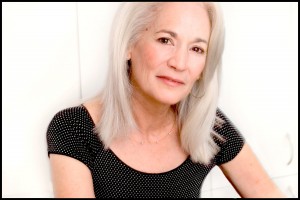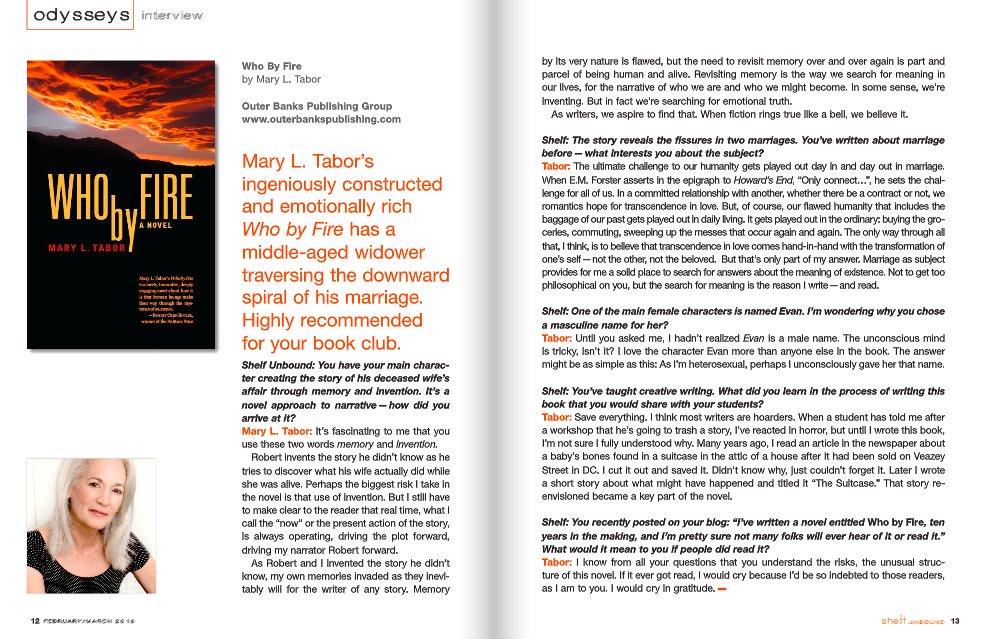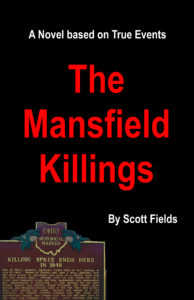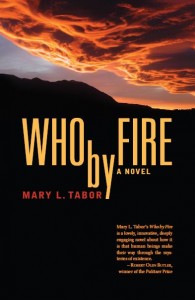


Outer Banks Publishing Group author Mary L. Tabor’s literary novel, Who by Fire, won the Notable Indie award for best books in 2013 by online magazine Shelf Unbound.
Shelf Unbound’s second annual writing competition had over 1,000 entries with 100 titles chosen as winners, according to Shelf Unbound’s publisher, Margaret Brown.
Mary’s book was featured in the December-January 2014 special edition of Shelf Unbound magazine (Page 35).
“Thanks to the Internet, artists can be discovered by a global audience-and in some cases even be funded by philanthropic strangers. The challenge, of course, is the discovery part-how do the indie artist and the indie audience find each other? That’s what this special issue of Shelf Unbound-honoring the winner, finalists, and notable entries in our second writing competition for best indie book-is all about,” wrote Ms. Brown.
Congratulations to Mary for her notable achievement!
Book reviews with GIFs, those tiny videos that play over and over, are rather controversial among the old guard of book reviewers. Read Laura Miller’s insightful and informative piece. Start with the excerpt below.
“The GIFs and images used in the two reviews are, like the vast majority of visual elements cropping up in reviews and other critical discussions online, reaction GIFs: looped clips taken from commercially produced film and television, often featuring popular actors such as Emma Stone or Jennifer Lawrence rolling their eyes, gaping in astonishment, jumping with glee, shrugging their shoulders. They serve to underline the reviewer’s point, rather than to make it, and they can come across as exaggerated and sarcastic, even bratty. But so what? It’s not as if traditionally published professional book reviews haven’t been equally harsh at times, and in this case, the reviews are highly attuned to their intended audience with its densely networked language of cultural references. Besides, as longtime Goodreads member Ceridwen (who doesn’t use images or GIFs herself) explained to me in an email, ‘These reviews often use the very same critical tools found in professional reviews — parsing of character and tone, close reading, comparison with other works or larger cultural positioning — [but] there’s no fiction of critical distance, and the emotional reaction is as important as the aesthetic one.'” >more
JCC Clip from Mary Tabor on Vimeo.
If you haven’t read the latest review by Small Press Reviews of Outer Banks Publishing Group’s Who by Fire by Mary L. Tabor, view the video and discover some significant revelations why people love, cheat and later regret what they did to a loved one.
Mary Tabor “Who By Fire” Reading from William Holloway on Vimeo.
For anyone who is creative, you must watch this video of Neil Gaiman’s address to the 2012 graduating class of the University of Arts in Philadelphia.
From the zenpencil.com blog:
“Neil Gaiman (1960-) is one of the best fiction writers in the world in my opinion. His work covers novels, short-stories, children’s books, comics, film, television – pretty much the whole pop-culture gamut.
This quote is taken from Gaiman’s commencement address at the University of the Arts in Philadelphia, which was all over the internet last week. In an absolutely beautiful and inspiring speech, Gaiman shares the best tips that he wished he knew when he was first starting his writing career. It’s required listening for anyone passionate about the arts and I’ve bookmarked it so I can watch it whenever I lose my direction. Seriously, if you haven’t seen it, stop what you’re doing and click here.”
Neil Gaiman Addresses the University of the Arts Class of 2012 from The University of the Arts (Phl) on Vimeo.
Outer Banks Publishing Group author Mary L. Tabor was interviewed by Shelf Unbound, the literary magazine for small press and independent books.
This is probably the most enlightening interview I have ever read on why writer’s write. A must read on Page 12.
Here is an excerpt from the interview – Mary explains how the main character, Robert narrates and invents the story as it is told.
“As Robert and I invented the story he didn’t know, my own memories invaded as they inevitably will for the writer of any story. Memory is by its very nature is flawed, but the need to revisit memory over and over again is part and parcel of being human and alive. Revisiting memory is the way we search for meaning in our lives, for the narrative of who we are and who we might become. In some sense, we’re inventing. But in fact we’re searching for emotional truth.”
You can find Who by Fire on Amazon in print or as an ebook and in bookstores and retailers everywhere.
It was the worst two-week killing spree in Ohio’s history. On the night of July 21, 1948, Robert Daniels and John West entered John and Nolena Niebel’s house in Mansfield, Ohio with loaded guns. They forced the family including the Niebel’s 21-year-old daughter, Phyllis, into their car and drove them to a cornfield just off Fleming Falls Road in Mansfield. The two men instructed the Niebels to remove all of their clothing, and then Robert Daniels shot each of them in the head.
Scott Fields of Mansfield, Ohio was so intrigued by this true story that he turned the horrific events into a page-burning novel that you cannot put down until you turn the last page. During a recent book signing in his hometown of Mansfield, Scott was approached by a man he had never seen before. The man introduced himself and Scott’s jaw dropped.
By Scott Fields
Author of The Mansfield Killings
I had just begun a book signing when a dignified, older man walked through the door. He stood in the back of the room as I finished with the person in front of me. He then approached me and shook my hand introducing himself as Roger Winger. I had no clue as to who he was in spite of his obvious pause as he waited for me to take heed of his presence.
“You don’t know who I am, do you?” he asked.
“No, I don’t,” I said. “Sorry.”
“In July of 1948, I saw the dead bodies of the Neibel family lying in a cornfield off of Flemming Falls Road.”
For several seconds I stood there with mouth open trying to comprehend what he had just told me. “What did you just say?”
“I actually saw the dead bodies.”
I grabbed him by the arm and led him into another room. “How could you have seen such a thing?”
“I was six years old at the time. I lived next to the cornfield where the Niebels were found. That day was like any other summer day. I had seen the group of boy scouts marching down Flemming Falls Road earlier in the day. I hardly gave notice because boy scouts on that road was a common sight to see. Later that day, I stepped outside my house to see find police cars, ambulances and even fire engines all up and down the road. Out of curiosity, I walked down to the cornfield. There were men rushing back and forth but seemed to be concentrating on a spot about 50 feet into the field. I cautiously walked through the corn stalks until I was within a foot or so from the spot where the three people had been shot.”
“Did you see the bodies?” I asked.
“Yes, I did. Their bodies had turned white and were extremely bloated.”
“Was there signs of blood?”
“No. I don’t remember seeing any blood.”
“That’s a bit surprising,” I said. “Considering th at they were shot in the head. What happened next?”
at they were shot in the head. What happened next?”
“One of the policemen saw me and yelled at me to get the hell out of here. I took off running thinking they were chasing me.”
“Daniels declared that they did not rape twenty year old Phyllis, and yet the bodies were found completely nude. The first coroner stated that there was no evidence of rape and yet the coroner at Daniel’s trial stated that she had been raped. Why do you think Daniels would admit to everything but deny raping Phyllis?”
“I’m not sure,” said Roger. “I personally think he did it. Back in those days, murder was one thing. Rape was another.”
Small talk followed, and soon we said our goodbyes. I did manage to get his phone number and address, because I have many more questions for him.
_______________________________________
The Mansfield Killings now at this special publisher’s discount price of $12.99 (List $14.99).
Publication Date: December 3, 2012
ISBN 10 – 0982993137
ISBN 13 – 978-0-9829931-3-2
Binding Type: US Trade Paper
Language: English
By MICHAEL JOHNSON
Novels about love affairs outside of marriage are a genre unto themselves and I try my best to avoid them. John Updike made a career of these stories anyway, so what’s left to say? Yet once in a while a new writer emerges with such sharp sensibilities, such descriptive powers, and such a rich story that I am forced to reconsider.
Mary L. Tabor is such a writer, and her new book, “Who By Fire” (Outer Banks, $17.95), launched a few weeks ago to a full house in a Washington, D.C. bookshop, kept me turning pages to enjoy the careful prose, the fascinating digressions and most of all the unspooling of the story.
To my mind, the story is the fire in the relationships. The ice is Ms. Tabor’s masterly control of the complex plot. The reader begins to suspect what is to come as hints are dropped along the path toward the climax. This book is hard to put down.
“Who By Fire” is a near-surgical dissection of the turmoil and pleasures that straying couples experience – and the effect on the betrayed.
Ms. Tabor takes the time to develop characters so that you care about what they are going through. She finally kills off Lena, the woman who succumbed to her lover’s charms, and she does it abruptly after setting the scene: “And then she died.”
 Mary Tabor is a writer who likes to say it is never too late. She started publishing her prose at age 60 and already has to her credit a frank memoir of her life and marriage entitled “(Re)Making Love: A Memoir.” Her best short stories are collected in “The Woman Who Never Cooked.”
Mary Tabor is a writer who likes to say it is never too late. She started publishing her prose at age 60 and already has to her credit a frank memoir of her life and marriage entitled “(Re)Making Love: A Memoir.” Her best short stories are collected in “The Woman Who Never Cooked.”
She takes stunning risks in her new novel, the most impressive being her decision to write from the perspective of Lena’s husband, Robert, the man who suffers as his emotions of widowhood and awareness of his dead wife’s affair mingle in his thoughts.
Jay McInerney tried the gender-swap in “The Story of My Life” but he never let you forget he was trying to sound like a girl. Ms. Tabor glides into the male perspective effortlessly and stays there.
As the narrator “Robert” reconstructs the story of his life, Ms. Tabor makes him recall what he had failed to see before his wife’s death:
“If I’d seen them on the street, I’d have known because they would have done the sorts of things that reveal: They would have passed between them a bottle of water, their hips would touch, as if by accident, when they walked; they wouldn’t touch with their hands the way safe lovers do, but an observant eye could catch both the intimacy and the caution—and know. It was when she was dying that I knew. It was the way he touched her head before he left her bedside. What I thought was an obligatory visit from a colleague changed with one gesture.”
I was propelled through this book most of all by the taut language, the dialogue and the perfect sentences, honed in the author’s years as a teacher of creative writing at George Washington University, Ohio State and University of Missouri, among others. From the outset, you are in the thrall of a confident storyteller.
Her digressions take the reader into worlds she clearly knows — the detail of the Dead Sea Scrolls, the art world, the finer points of classical music, quantum physics and the business of psychology. She has her psychologist character Evan say at one point:
“I’m beginning to think I give more comfort than cure. Not such a bad thing but not what I expected. I feel like an old broom—cleaning up, moving around the messes in people’s heads, never sure if that’s all I’m doing.”
She will throw odd words at you and expect you to understand. The apple trees are espaliered. The plants are pleached.
I was drawn into the suspense when the lovers realize that the betrayed wife is returning home early. With cinematic realism, the lovers find themselves about to be discovered when they hear the key in the lock:
“A familiar sound, merely a click, but they thought, almost as if their minds were one, that they heard the separate mechanisms of the lock moving, tumbling like thunder.”
This reader quickly turned the page to watch them awkwardly lie their way out of trouble.
Mary L. Tabor tells me she is at work on a new novel. Somehow she finds time to do a weekly internet interview about writing, broadcast on Rarebirdradio.
It is never too late, as she would be the first to tell you.
 Who by Fire is told by Robert, Lena’s husband, as he attempts to understand her affair with Isaac, an affair that he has become aware of after her death. He imagines the story of his wife and her lover.
Who by Fire is told by Robert, Lena’s husband, as he attempts to understand her affair with Isaac, an affair that he has become aware of after her death. He imagines the story of his wife and her lover.
Robert the narrator is trying to know himself in the story he is writing as he tells his imagined version of his wife’s betrayal. The story becomes a paradoxical tale of his own undoing that he comes to realize by telling it.
In the epigraph to the novel, Robert says, “Life has a way of raveling. Story discovers how it happened. That is the fiction.” This is the reader’s first introduction to Robert’s persona, a man who must control the world he inhabits. The telling of the story as he imagines it, reveals more than he would have wished and as this occurs, his telling moves into real time, for there is no way for him to deal with what he discovers except to report what is actually happening versus what he has imagined.
Pre-publication praise:
Michael Johnson, foreign correspondent and writer for The International Herald Tribune, American Spectator and The Washington Times: Mary Tabor’s captivating story of love and death tackles the tangle of relationships within and outside the bonds of marriage. Her eye-popping knowledge of men’s and women’s behavior is effortlessly recounted as couples face their anguished choices. Set in a world of art, music, anthropology and science, her novel enlightens the mind while it stirs the emotions. She does all this in a confident style of prose that ranks her alongside the finest novelists working today.
Paperback: 248 pages
ISBN: 978-0-988299-314-9
Language: English
Product Dimensions: 5.5 x 8.5 inches
Publication Date: November 2012
Newly-published author, Scott Fields talks openly about his writing, how he does it and his newest book, Summer Heat.
When she was 17, there wasn’t a man alive she would let get near her, and when she was 18, there wasn’t a man she would keep away.
She stood five feet seven inches tall, weighed one hundred twenty pounds, her green eyes sparkled like brilliant cut emeralds, her inviting full lips always ruby red and moist.
Women universally hated her, men continued to hold doors for her long after she passed by – just to watch her walk away. To imply that Jessie exuded sex would be an understatement, akin to inferring that water was wet.
Ninety-nine point nine percent of the men in Steam Corners wanted her, but she only wanted one man, Spencer Deacon. He was everything that she was not, even-tempered, amicable, well respected and kind. The one thing that Spencer didn’t want was Jessie, and his firm and undeniable rejections infuriated her.
What followed was a series of sordid events involving murder, deceit, betrayal and the conviction of an innocent man.
_______________________
Publisher: I couldn’t help but notice that your latest novel, Summer Heat, is quite diverse from some of your earlier novels which were small town, nostalgic works. Why is this book different?
S. Fields: All my life I’ve had this obsession with ideas for stories. I never know when one of these germs is going to somehow penetrate my head. I certainly have no control of it. It just happens. I’ve written 12 novels, 8 screenplays and 13 short stories, and each one of them was inspired by one of those germs that was implanted in my head. I’m always writing something, and all the while I have four or five story ideas buzzing in my head.
Publisher: Bestselling author James Patterson has the same problem. Maybe you could give us a little history of your writing career.
S Fields: All my life I’ve always wanted to write. I didn’t really get started until I went to college. Believe it or not, I turned down a contract from the Detroit Tigers, so that I could go to college and learn to write, a decision I’ve questioned more than once. The sad part is that I learned that nobody can teach you to write. The only way to learn is by simply writing, and I mean writing everyday. To hone the craft to an art form, one must be dedicated to the point of obsession. After college, I continued writing short stories and was lucky enough to have four of them published. Later, I began to write novels and now my fifth one has been launched by Outer Banks Publishing.
Publisher: So you actually turned down a chance to be a professional baseball player. That must have been a difficult decision.
S Fields: You have no idea. I was drafted in 1966 after graduating from high school. There were over 700 young men in that draft, and I was the 34th pick. You better believe that was a tough decision.
Publisher: How long does it take you to write a novel?
S Fields: Up until a year ago, I was working a full time job, and most of my books would take about a year to write.
Publisher: Where did you get the idea for this one? Was it another one of those germs from out of nowhere?
S Fields: I was driving along the highway. My wife was asleep, and my mind was in neutral thinking about what I was going to do when I got home. The next thing I know I get this idea about a young, sleazy woman who loves to party married to an older, serious-minded farmer. Every man in town wants her, but she wants a young, Afro-American man. To her frustration, this young man wants nothing to do with her sexually.
Publisher: I’m a bit surprised that someone who writes warm and fuzzy stories could write such a book.
S Fields: Most authors have a certain genre that is their expertise. It is a genre in which they excel. Stephen King is famous for his books of horror, and Danielle Steele writes women’s fiction. I write whatever excites me at the time. I have no niche or particular genre to call home. I even wrote a book about two men who went on a killing spree back in 1948. In a two week period, they murdered 6 people in Ohio. Even after all these years, it still remains the worst killing spree in Ohio’s history. On the other end of the spectrum, I wrote a religious book called Just Believe. Actually, I hope I never settle for one particular genre. I think I would get bored.
Publisher: Where are all of these projects that you have written? You’ve only had four novels published.
S Fields: They are buried somewhere in my computer. Generally, when I finish a project, I’m aching to get started on a new one. Many of my projects were written years ago and have been forgotten.
Publisher: Have you ever dreamed of becoming a nationally-known author?
S Fields: I’m sure every writer has a one time or another dreamed of seeing his books in stores across the nation. I like to keep things in perspective. I consider writing as my hobby, then I’m never disappointed.
Publisher: Do you think Summer Heat will be successful?
S Fields: Not to appear immodest, but, yes, I do. Women’s fiction in 2004 represented 55 per cent of all book sales. Today’s trend is thrillers, but women’s fiction is still right up there.
Publisher: Well, we believe Summer Heat is a hit.
S Fields: Thank you very much.
Photo of Scott during a recent book signing at the Mansfield/Richland County Public Library in his hometown of Mansfield, Ohio.
___________________
About Scott
In 1996 with a lifelong dream of being a writer, Scott Fields started writing short stories. Within the next two years, he had four stories published. Since then, his first novel, All Those Years Ago, was published, and in the fall of 2004, his second novel, A Summer Harvest, was released. His third novel, The Road Back Home, was published in the fall of 2007 by Charles River Press, and his fourth novel, Last Days of Summer, was released by Whiskey Creek Press.
He was born and raised in La Rue, Ohio, a small village nestled in the farmlands of mid-Ohio. It was there that he learned to appreciate small town life and country living, which he incorporates into his novels. He graduated from Ohio University in 1970 with a degree in English Literature.
Scott and his wife, Deb, now live in Mansfield, Ohio. Their children, Sara, Angela, Michael, and Matt live in the Detroit area.
_______________
Summer Heat is available in print from The Outer Banks Publishing Group Bookstore at a special discount of $9.99 and on Amazon, the Kindle, and bookstores everywhere.
Paperback: 212 pages
Language: English
ISBN-10: 0982993110
ISBN-13: 978-0982993118
Product Dimensions: 8 x 5 x 0.5 inches
Shipping Weight: 10.4 ounces